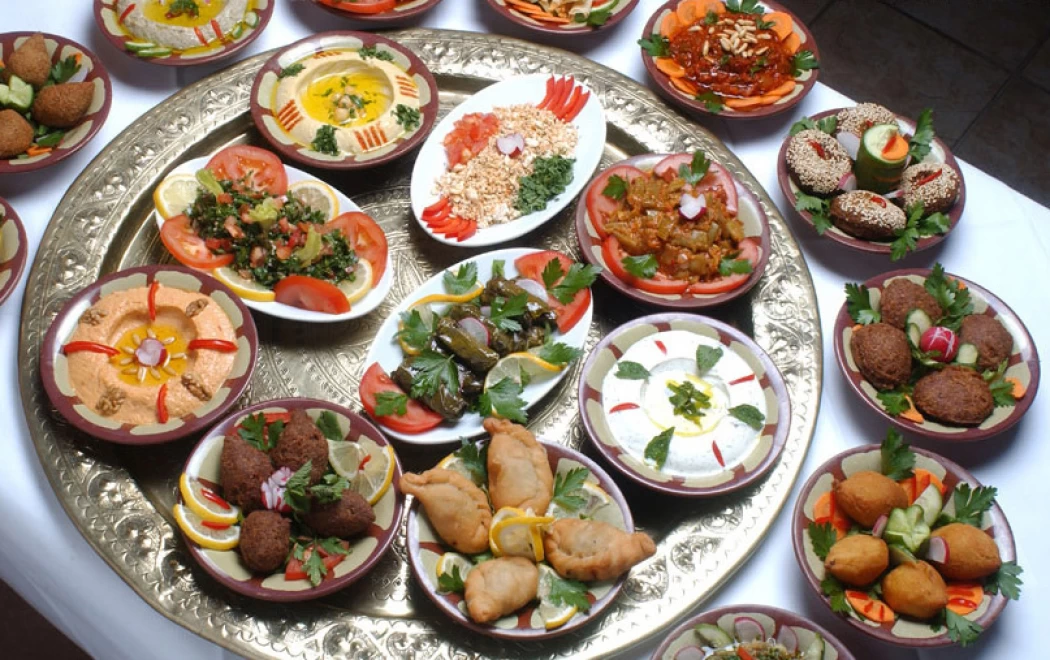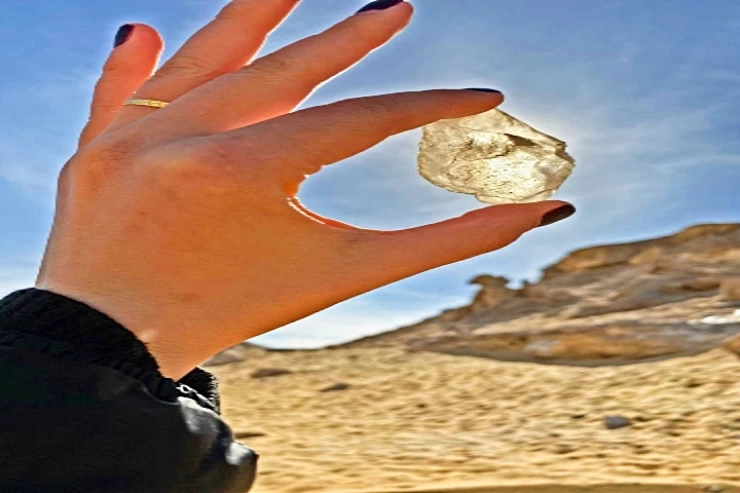
Historical pleasures of Egyptian cuisine
Egyptian cuisine includes rice-stuffed vegetables and grape leaves, hummus, falafel, shawarma, kebab, and kofta. Other dishes include ful medames (mashed fava beans), koshary (lentils and pasta), and molokhia (bush okra stew). Eish baladi is a native pita bread. Cheesemaking in Egypt dates back to the First Dynasty, with Domiati being the most common sort of cheese consumed today.
Egyptian cuisine is primarily vegetarian and legume-based, but it can sometimes include meats such as squab, chicken, and lamb. Grilling is commonly done with lamb and beef. Offal is a popular quick food in cities, and foie gras is a delicacy that has been made in the region since at least 2500 BC. Fish and seafood are abundant in Egypt's coastal regions. Because of the historically high cost of meat and the needs of the Coptic Christian community, which requires practically vegan diets for part of the year, a substantial portion of Egyptian cuisine is vegetarian.
Tea is Egypt's national drink, and beer is the most popular alcoholic beverage. While Islam is the dominant religion in Egypt, and observant Muslims tend to avoid alcohol, alcoholic beverages are nevertheless widely available in the country. Pork intake is likewise prohibited for Egyptian Muslims, hence it is only permissible for Egyptians who are not Muslim. Baqlawa, basbousa, and kunafa are among Egypt's most popular desserts. Desserts often contain dates, honey, and almonds.
Sorghum, like millet, was grown in Upper Egypt, although it was not a popular crop among Cairo people. It was only consumed during times of famine or scarcity when sorghum was chosen above other wheat substitutes used to manufacture emergency bread rations such as millet, bran, or broad beans.
In The Tale of Judar and His Brothers, an Egyptian story from Thousand and One Arabian Nights, the main character, a poor fisherman named Judar, gets a magic bag belonging to a necromancer of Maghrebi descent. This bag provides its owner with food such as rozz falafel, a rice dish seasoned with cinnamon and mastic, occasionally colored with saffron, and prepared stock and tail fat.
Ancient Egyptian food included not only bread and drink, but also fruit, vegetables, and fish for the poor. Many of the carvings depicting gastronomy are from the Old and New Kingdom periods.
Egyptian cuisine is particularly suited to vegetarian diets, as it is heavy on bean and vegetable dishes. Though food in Alexandria and around Egypt's coast sometimes includes fish and other seafood, Egyptian cuisine is mostly based on crops that grow in the ground.
Egypt's Red Sea ports were the primary sites of entry for spices into Europe. Egyptian cuisine has been influenced by the easy availability of numerous spices over the years. Cumin is the most often used spice. Other frequent spices include coriander, cardamom, chile, anise, bay leaves, dill, parsley, ginger, cinnamon, mint, and cloves.
Pigeon, chicken, and duck are common meats used in Egyptian cuisine. These are frequently boiled to provide the broth for various stews and soups. The most common meats for grilling are lamb and beef. Mashwiyat refers to grilled meats such as kofta, kabab, and cutlets.
Offal, or a variety of meats, is popular in Egypt. Liver sandwiches, an Alexandria specialty, are a popular fast food option in cities. Chopped liver fried with bell peppers, chile, garlic, cumin, and other spices is served in a baguette-like bread known as eish fino. Egyptians consume cow and sheep brains.
Egyptians continue to appreciate foie Gras, a well-known delicacy. Its flavor is regarded as creamy, buttery, and delicate, unlike that of typical duck or goose livers. Foie Gras is sold whole or made into mousse, parfait, or pâté, and it can also be served as a complement to other foods, such as steak. The process of gavage, or shoving food down the throats of domesticated ducks and geese, dates back to 2500 BC when the ancient Egyptians began keeping birds for food.
Cheeses include domiati , the most widely eaten in Egypt;[16][17] Areesh cheese manufactured from laban rayb Rumi cheese, a firm, salty, ripened form of cheese that belongs to the same family as Pecorino Romano and Manchego.
The local bread is a form of hearty, thick, gluten-rich pita bread called eish balad meaning "to live, be alive." The word means "life, way of living...; livelihood.
Egypt's government subsidizes bread, a program that dates back to the Nasser era. In 2008, a serious food crisis produced ever-longer bread lines at government-subsidized bakeries where there would ordinarily be none; occasional battles over bread erupted, resulting in 11 deaths. Egyptian dissidents and outside observers of the former National Democratic Party regime frequently criticized the bread subsidy as an attempt to buy off Egypt's urban working classes to promote acceptance of the authoritarian system; however, the subsidy persisted after the 2011 revolution.
Bread is often utilized as a tool in Egyptian cuisine, while also delivering carbohydrates and protein. Egyptians use bread to scoop up food, sauces, and dips, as well as wrap kebabs and falafel, to keep their hands from becoming greasy. Most pita breads are baked at high temperatures (450 °F or 232 °C), causing the flattened rounds of dough to expand substantially. When removed from the oven, the layers of baked dough remain divided within the deflated pita, allowing the bread to be opened into pockets and used in a variety of meals. Common breads include:
In Egypt, meze, also known as salatat, includes salads, cheeses, and bread before the main dish.[22] Popular dishes include:
Baba ghannoug is a dip consisting of eggplant, lemon juice, salt, pepper, parsley, cumin, and oil.
Duqqa is a dry mixture of chopped nuts, seeds, and spices.
Salata Baladi — a salad made with tomatoes, cucumber, onion, and chili topped with parsley, cumin, coriander, vinegar, and oil.
Tehina —a sesame paste dip or spread made of sesame tahini, lemon juice, and garlic.
Torshi —an assortment of pickled vegetables
Egyptian cuisine is characterized by dishes such as ful medames, mashed fava beans; koshary, a mixture of lentils, rice, pasta, and other ingredients; molokhiya, chopped and cooked jute leaf with garlic and coriander sauce; and feteer meshaltet.
most popular dishes. Falafel, also known as ta'ameya in Egypt, is made from fava beans and served with fresh tomatoes, tahini sauce, and arugula.
Egyptians are notorious for using a lot of garlic and onions in their daily recipes. Fresh garlic blended with other herbs is used in spicy tomato salad and can also be put into boiled or baked eggplant. Garlic cooked with coriander is added to molokhiya, a famous green soup made from finely chopped jute leaves and sometimes chicken or rabbit. Fried onions can also be added to the koshary.
Culinary Expeditions in Egyptian Food: History and Gastronomy in One Buffet
Each nation has its specialties and recipes that draw from time, culture, geography, and so on, and Egypt is not an anomaly in that order. Egyptian food culture has existed and flourished for thousands of years, and their culinary practices may constitute the simplest of natural ingredients, but they have always been rich and flavorful. Whether swirling through the street markets of Cairo, having seemed more exotic than any empire’s cuisine while dining by the Nile, or tucking into the home-cooked food of relatives in a village in Egypt, one finds the thrill of finding new and exciting combinations of flavors and cuisines in the Egyptian culinary experience, which is also home to wondrous sights.
We can begin from the very first Egyptian bread ovens installed by the Pharaohs and come to the kitchens of today. This only goes to show that Egyptian food is very traditional but at the same time takes in a lot from Italy, the Middle East, Africa, and other places. Now let’s get ready for exploration—culinary exploration to be more exact—and examine the unique features, typical cuisine, and role of eating in Egypt.
A Historical Feast: The Origins of Egyptian Cuisine
The history of food in Egypt dates back to the Pharaoh's time. This is because ancient Egyptians played a great role in agriculture, growing wheat, barley, vegetables, and fruits along the banks of the Nile, which was very fertile. The making of bread was integral to the people, and learning to bake bread is among the oldest culinary practices in Egypt. On tomb paintings and hieroglyphs, images of an intact banquet consisting of bread, fish, meat, fruits, and beer are illustrated, which indicates the significance of food in ancient Egypt.
Throughout the ages, Egypt’s culinary art has changed due to many factors over the centuries. For instance, the Greeks, the Romans, and many other civilizations including the Ottomans and Arabs had a role in these changes. Each civilization made contributions in one way or another, bringing along new herbs, cooking methods, and food elements that fused with the ethnic culture of the region to give rise to the effective and delicious cuisine that we have nowadays.
The cuisine of Egypt is characterized by the use of uncomplicated and healthy ingredients, most of which are produced in Egypt itself. Here are some of the main elements that are central to the practice of cooking in Egypt:
Fava beans (ful): Fava beans are one of the most popular ingredients in Egypt, featuring in full, another traditional dish in which fava beans are stewed, and taameya, or Egyptian falafel.
Bread (Aish Baladi): In every Egyptian meal, there is bread included. The most familiar is called aish baladi, which is a circular flatbread made from whole wheat flour slightly thicker than pita and used extensively. It is used to scoop food, wrap around food, and with many other dishes.
Rice: In Egyptian culture, rice is often served as a side dish and is usually exceptional to dishes like gumbo, grilled dishes, or loaded up with other ingredients and spices.
Lentils: The lentil pulse is popular and often used in many Egyptian plates; for example, these include soups, stews, and kosher.
Herbs and spices: One of the main reasons is that most of the food is also full of warm and earthly favors. So, fresh herbs like cilantro, parsley, dill, and spices like cumin, garlic, cinnamon, and turmeric are often added in cooking.
Molokhia: Another quintessential favorite from Egypt is molokhia, which is derived from a green leafy plant with a warm and gooey texture served as a garlicky soup and eaten with rice or bread.
Within Egypt's extensive history, there exists an array of Egyptian dishes that are quite distinct from one another. Thick hearty stews, deep-fried street snacks, and sugary desserts that provide warmth—there is something for everyone. Below are some of the primary dishes that typify the Egyptian food culture:
1. Ful Medames: The National Dish of Egypt
Ful medames, or farinaceous porridge, as it is better known, is a delicious, rich food consisting of seasoned, slow-cooked fava beans with olive oil, lemon, garlic, and cumin. Normally it is taken for breakfast with additional healthy foods such as fresh bread and eggs and some other vegetables like tomato, onion, and cucumber. Being Egyptian national food, it is highly appreciated by residents, and clearly for the tourists, it is a must-dish. This uncomplicated and delicious it has been part of culinary history for many generations, even from Pharaoh’s reign.
2. Taameya: Egyptian Falafel
Globally referred to as felafel, the taameya is the Egyptian equivalent of this popular street food. Unique to the Egyptian version of taameya is the use of fava beans instead of chickpeas to prepare also lighter, airier, and fluffier balls than the rest. Light, crispy, and deep-fried golden brown fritters flavored with herbs—coriander and parsley—would usually be sandwiched in between tahini, salad, and pickles. Taameya can be eaten as a snack or consumed as a meal, and it will prove hard to resist for anyone who tries it.
3. Koshari: The King of Street Food
The most popular street food in Egypt is kosher. Meaning “a mixture,” comfort comes naturally wherever this staple meal type exists. Koshari consists of rice, lentils, macaroni, and chickpeas, which are further topped with a delicious tangy tomato sauce as well as crunchy fried onions and spicy garlic vinegar. Due to its filling properties and inexpensive price, this carbohydrate-rich food entices every Egyptian citizen across all strata. Although kosher boasts simple and cheap ingredients, the dish is a complex jumble of flavor and texture and is highly seasoned.
4. Molokhia: A Green, Garlicky Delight
One of the first food experiences that leaves visitors to Egypt oftentimes unprepared is the strangely tasty and textured dish called Molokhia. The dish consists of cooked mookhia leaves (which are the jute leaves), blended with garlic and coriander to make an edible green paste. This dish is often served together with rice or a dish called aish baladi (Egyptian bread) and is sometimes eaten with chicken, rabbit, or beef. The slimy feel of the dish may take some getting used to, but it is a treasured dish among the Egyptians because of the comfort it brings along with the flavor of the dish, which is not normalized.
5. Mahshi: stuffed vegetables
Mahshi is a common term for toppings stuffed into vegetables such as zucchinis, peppers, or grape leaves that contain rice, spices, and sometimes meat. The stuffing is the center of having tomatoes, onions, and all the spices, which results in the rich and interesting taste of the dish. Mahshi is often cooked on holidays and parties due to the time and effort invested in cooking it. This dish consists of tender soft vegetables in every bite filled with aromatic rice, making it a perfect yummy comfort food back home in Egypt.
6. Fattah: A Festive Feast
Fatet, located in the middle of the plate, is a celebratory platter put together only on rare occasions, such as wedding parties or religious festivities. It consists of crisp, deep-fried bread pieces, rice, and stewed meat, all drenched in vinegar and garlic sauce. The way of serving and eating changes as the dish is filled with broth, resulting in a sumptuous and rich dish that fills one's stomach. In Egyptian traditions, Fattah connotes plenty and refreshment and is thus served and savored on occasions such as feasts and family get-togethers.
7. Hawawshi: Egyptian Meat Pie
Ful medames is a popular street food in Egypt made from boiled fava beans seasoned with olive oil, salt, and cumin. Hawawshi can be considered the Egyptian version of a meat pie. Ground, spiced, and cooked meat, often combined with vegetables and will almost always contain herbs, is present in a pocket of pita bread and oven-baked. The end product is a very sumptuous, tasty, and moist filling beautifully enveloped in a crisp crust. Hawawshi is well-loved by many as a street bite and is ideal for snacking in a hurry or for a quick lunch.
And no exploration of Egyptian gastronomy would be seen as if without having a taste out of its sweetest part. Egyptian sweets are heavy and rich, loaded with nuts, honey, and spices. Below are some of the famous confections found in the native country:
Basbousa: Syrup cake garnished with either almond or coconut. In Egypt, this sweet, moist cake is symbolic of festivities, and it is served in almost all functions.
Konafa: Pestilious stuffing of nuts, cream, or cheese, prohibitively sweetened and layered in a cake made of a very thin chick pastry rolled into slippery threads. In many Arabic countries, konafa is served during the holy month of Ramadan and other feasts.
Om Ali: Egyptian pudding made of layers of marinated and baked phyllo dough and milk with nuts, raisins, and spices. This rich and hearty dessert is usually prepared during festive occasions like family gatherings and cultural events.
Shai is among the beverages that are most enjoyed in various aspects of life in Egypt, more so in gatherings. It is typical for the Egyptians to consume tea without milk, sweetened with sugar, or flavored with a bit of mint. In the case of many Egyptians, tea is not just another drink but an intricate cultural aspect because it represents hospitality and relaxation, especially after a heavy meal or while engaged in social activities with friends. In addition to tea, Karkadeh, which can be referred to as hibiscus tea in English, is another beverage well appreciated in Egypt characterized by its unbelievable red color and a tasty sourness.


















